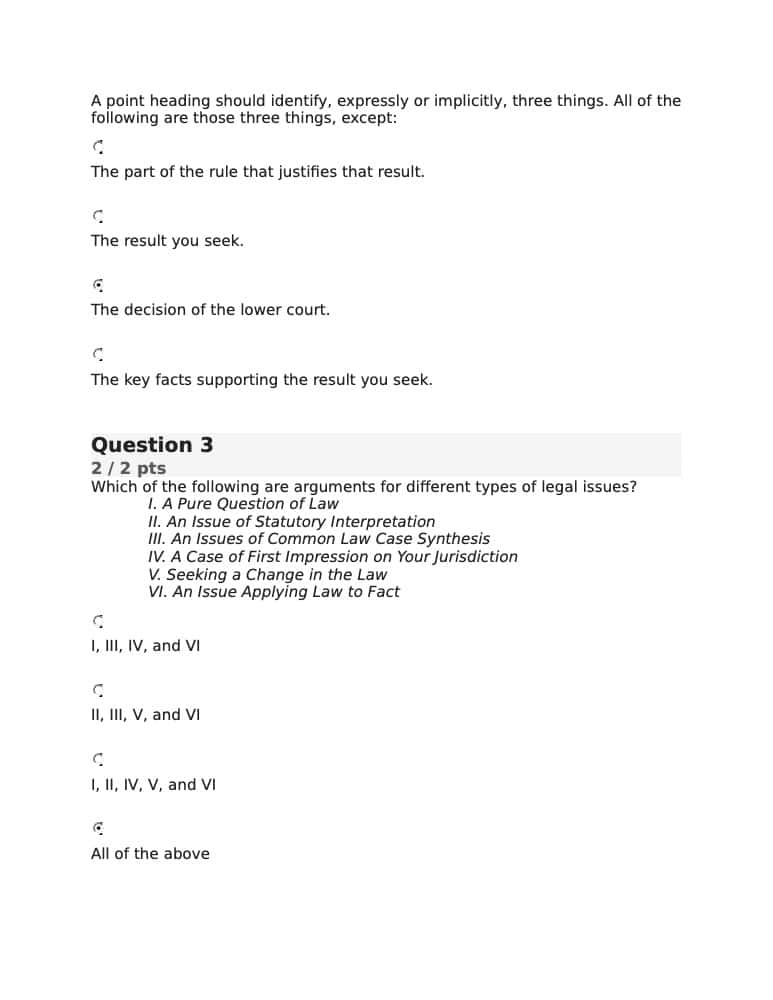JURI 515 Quiz 2
JURI 515 Quiz 2 Liberty University
JURI 515 Quiz 2 Memo and Brief Writing
Covers the Textbook material from Module 3: Week 3 — Module 4: Week 4.
- Umbrella sections are
- A point heading should identify, expressly or implicitly, three things. All of the following are those three things, except:
- Which of the following are arguments for different types of legal issues?
- An umbrella section can serve four main functions, which of the following is not one of those functions.
- A similarity or difference is legally significant if it relates to:
- The main forms of legal reasoning used in rule explanation include all of the following, except:
- When deciding which similarities and differences are significant, it is essential to compare the key terms (elements or factors) of the governing rule. In the following rule statement, what are the two key terms (elements)?
- The three most common choices for the order of single-issue discussions include all of the following, except:
- The statement, “[w]here the bargaining positions of certain kinds of parties are grossly disparate, the governing rule should protect the weaker party” is considered a policy rationale.
- An office memo is an internal working document. It is not for outside readers, although clients and others might receive a copy if the need arises.
- If a subsection strikes you as particularly long and complex, it is unnecessary to consider further subdivisions with headings.
- Analogical reasoning can provide the critical connection between your client’s facts and the way the rule has been interpreted in prior cases.
- If the form of your document permits, a conclusion paragraph pulling together the results of each separate analysis and setting out the ultimate conclusion on the question presented should be included.
- The Short-Form Case Comparison uses an extensive in-text discussion of the case to give the reader more information about the cited case and about the relevant comparisons.
- In most cases, policy and principle-based reasoning will be your most valuable tools in explaining the rule’s purpose.
- Two of the potentially most persuasive parts of a brief are the Questions Presented (Issue Statement) and the Point Headings.
- Relevant facts are those that help you decide how the rule of law will apply to your client’s situation.
- It is acceptable if a brief-writer makes a knowing mistake when stating the facts.
- If you think that the application is obvious and that there is no need to talk about the facts, then it is unnecessary to discuss them.
- Headings can be used to help the reader quickly navigate the document by making large-scale organization visible at a glance.
- Match the following: Standard of Review Question of Fact Question of Law Statement of Facts Bluebook Short-form citation Period Id.
Set 2
- Which of the following are arguments for different types of legal issues?
- An umbrella section can serve four main functions, which of the following is not one of those functions.
- When deciding which similarities and differences are significant, it is essential to compare the key terms (elements or factors) of the governing rule. In the following rule statement, what are the two key terms (elements)? A seller must disclose if: the seller is aware of or should be aware of the defect, and the defect is obvious.
- The three most common choices for the order of single-issue discussions include all of the following, except:
- The main forms of legal reasoning used in rule explanation include all of the following, except:
- A similarity or difference is legally significant if it relates to:
- Umbrella sections are
- A point heading should identify, expressly or implicitly, three things. All of the following are those three things, except:
- If a subsection strikes you as particularly long and complex, it is unnecessary to consider further subdivisions with headings.
- It is acceptable if a brief-writer makes a knowing mistake when stating the facts.
- If the form of your document permits, a conclusion paragraph pulling together the results of each separate analysis and setting out the ultimate conclusion on the question presented should be included.
- Analogical reasoning can provide the critical connection between your client’s facts and the way the rule has been interpreted in prior cases.
- The statement, “[w]here the bargaining positions of certain kinds of parties are grossly disparate, the governing rule should protect the weaker party” is considered a policy rationale.
- The Short-Form Case Comparison uses an extensive in-text discussion of the case to give the reader more information about the cited case and about the relevant comparisons.
- Two of the potentially most persuasive parts of a brief are the Questions Presented (Issue Statement) and the Point Headings.
- Headings can be used to help the reader quickly navigate the document by making large-scale organization visible at a glance.
- Relevant facts are those that help you decide how the rule of law will apply to your client’s situation.
- If you think that the application is obvious and that there is no need to talk about the facts, then it is unnecessary to discuss them.
- In most cases, policy and principle-based reasoning will be your most valuable tools in explaining the rule’s purpose.
- An office memo is an internal working document, designed to be read by those working within the office and a few select members outside of the office.
- Match the following:
- Analogical reasoning
- Long-form case comparison
- Short form case comparison
- Question presented
- Brief answer
